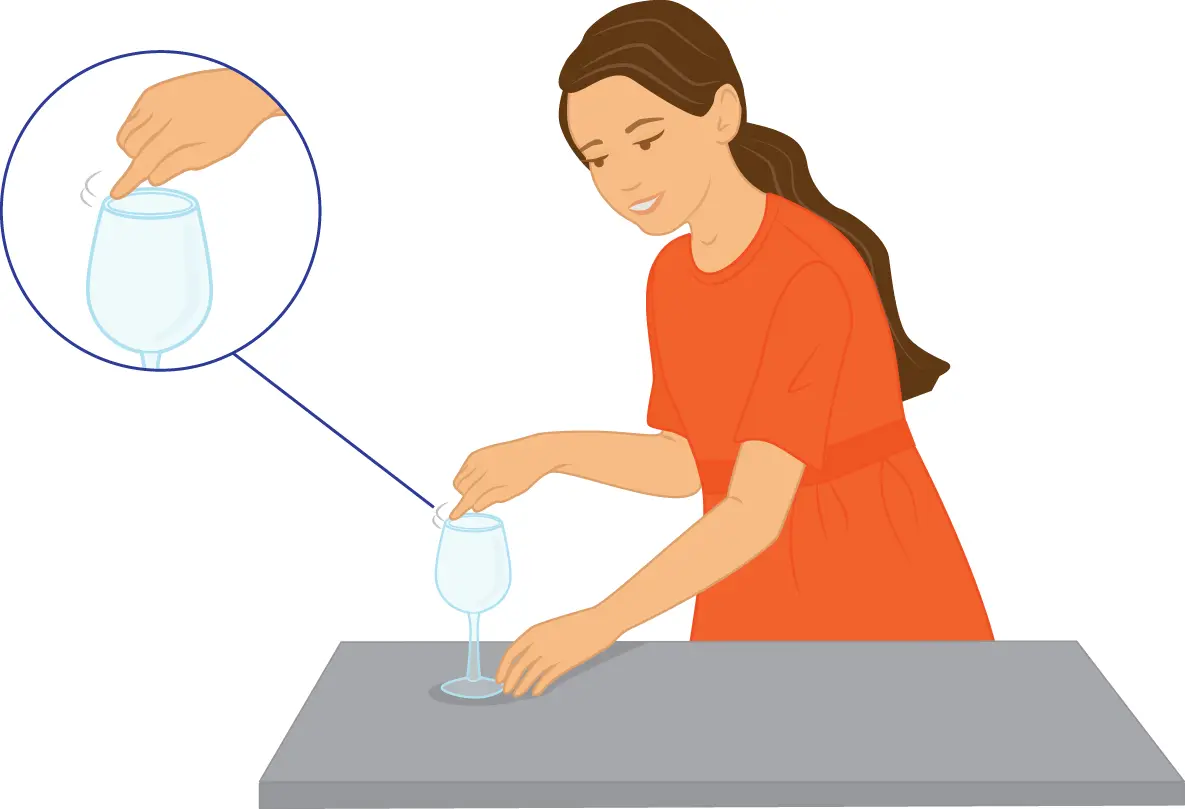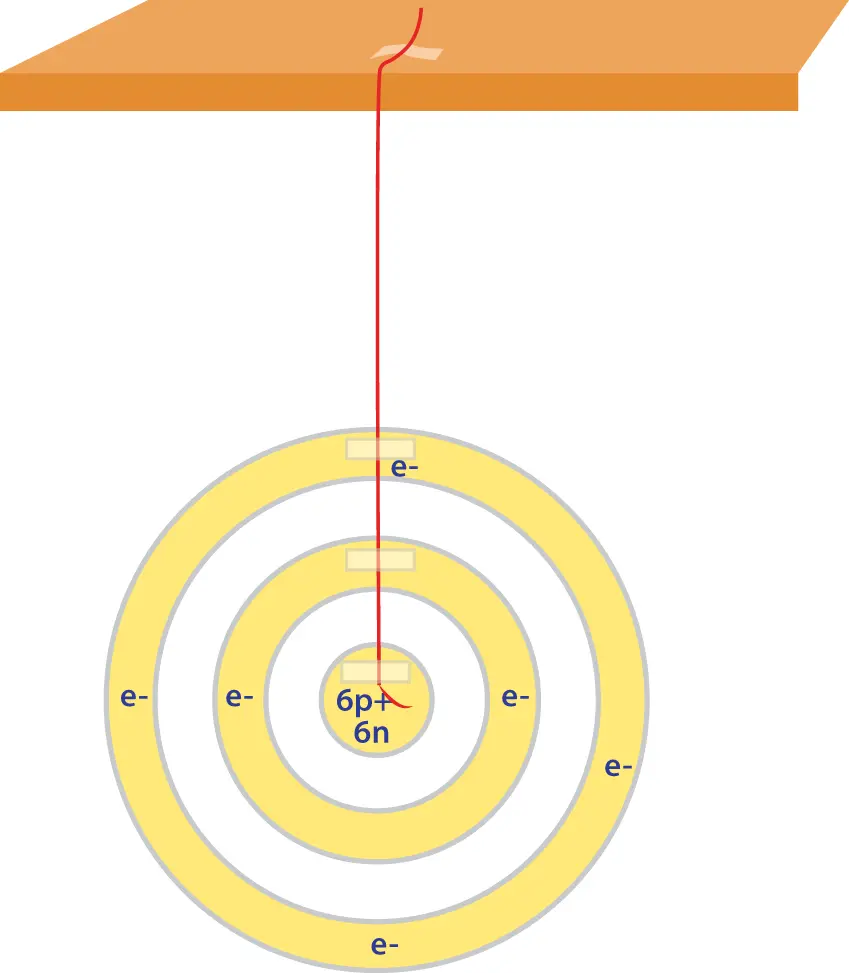8 The Effect of Mass on Sound
Mass isa measure of the amount of matter in an object. For example, some drinking glasses are thicker than others, thus they are more massive. In reference to sound, the more massive a vibrating object, the lower the frequency, and hence the pitch. The reverse is true if the mass decreases with a result of a higher frequency and higher pitch.
In this activity, water will be added to glasses to change their mass. Tapping on a glass with water will produce a sound with a certain frequency. It will be seen that increasing the mass of a glass and then tapping on it will produce a sound with a lower frequency. Altering the amount of water in the glass can produce different musical notes.
See for Yourself
Materials
6 drinking glasses of equal size and shape (the thinner the glass walls, the better)
water
food coloring
pencil
1 Pour different amounts of water in five of the glasses. Leave one glass empty.
2 Using food coloring, make the water in each glass a different color. Note: The coloring doesn't change the sound that will be produced. It merely helps to associate each glass with the sound it produces.
3 Gently tap each glass with the wooden end of a pencil.
4 Compare the sounds made by each glass with water to the sound produced by the empty glass. Determine which produces the highest and the lowest frequency.

FIG 1
An experimental challenge is to alter the amount of water in each glass to produce the notes to play a simple song.
The sound produced by tapping each glass was different depending on the amount of water it contained. The sound heard also depended on the sound produced by the glass; thus, an empty glass was used that vibrated the fastest when tapped, so it had the highest frequency and the note was high. A glass with water in it vibrated slower when tapped because the glass and water together had a greater mass. The greater the mass, the slower the vibrations of the glass when tapped. Slower vibrations mean a lower frequency of sound waves. The high and low musical notes produced are related to frequency. High notes are produced by high frequencies and low notes by low frequencies. Adjusting the level of water in a glass can result in notes that go up or down the musical scale.
Natural frequencyis the frequency at which a material vibrates when hit, plucked, strummed, or somehow set into motion. When a tuning fork is struck, it vibrates at a specific frequency: its natural frequency. As a tuning fork vibrates, it causes the air around itself to vibrate, which produces the sound waves you hear. A simple motion, such as rubbing the rim of a glass, can cause it to vibrate at its natural frequency and produce sound.
See for Yourself
Materials
stemmed glass (this will work best if the glass is thin)
dish detergent
small bowl of water
1 Remove excess oil from your hands and clean the rim of the glass by washing with dish detergent and rinsing well. Dry your hands and the stemmed glass thoroughly.
2 Place the glass on a table.
3 Hold the base of the glass against the table with your hand.
4 Wet the index finger of your free hand with water and move your wet finger in one direction around the rim of the glass pressing gently.

FIG 1
The glass starts to “sing.” Washing your hands removes any oil that might act as a slippery lubricant. Rubbing a wet finger around the rim causes the glass to vibrate. Due to friction, your finger skips and pulls at the glass as it moves around the rim. Just in the way a tuning fork begins vibrating when struck, this irregular touching on the glass rim actually acts like tiny taps that cause the glass to begin vibrating. In turn, the air inside and outside the bowl of the glass is struck by these vibrations and begins to move back and forth in a wavelike pattern. These sound waves spread out in all directions from the vibrating glass. A musical tone can be heard. The pitch of the sound you hear is due to the natural frequency of the glass.
A neutral atomhas no electric charge. Atomsare the building blocks of matter. Think of it as the stuff of which everything in the Universe is made. The center of an atom, called the nucleus, holds both protons, which are positively charged particles, and neutrons, which are particles with no charge. Electronsare negatively charged particles that spin around the nucleus at different distances called energy levels.
A neutral atom has an equal number of protons and electrons; thus, it has an overall net charge of zero. Much like the addition of +1 and −1 equals 0, the sum of one positive charge from one proton and one negative charge from one electron also equals zero.
The Bohr modelof an atom looks much like a model of planets orbiting the Sun at different distances. Comparatively, in the Bohr model, negatively charged electrons orbit a positively charged nucleus in different energy levels. The Bohr model of an atom can be demonstrated with a paper model.
See for Yourself
Materials
blank paper
pencil
scissors
tape
1 Fold the paper in half three times, once from top to bottom, and then from side to side, and last fold along a diagonal line so that the top folded edge meets the side fold as shown in Figure 1. FIG 1
2 Draw five curved lines on the top layer of the folded paper.
3 Cut along each of the five curved lines. Keep the three indicated sections as shown in Figure 2. FIG 2
4 Unfold the three sections; write “6p+” and “6n” in the circle, which represents the six protons and six neutrons in the nucleus of the atom.
5 In the smaller ring, draw two electrons (e−) on opposite sides, and in the largest ring, draw four electrons (e−) randomly spaced and as far apart as possible.
6 Connect the three parts by taping the string to each as shown in Figure 3. Secure the end of the string to a surface so that the atom model can hang freely.

FIG 3
This Bohr model is of the element carbon (C). The carbon atom model is neutral because it has six positively charged protons (p +) in its nucleus and six negatively charged electrons (e −) in the rings, which represent energy levels. In the Bohr model, atoms may hold up to two electrons in the first ring and up to eight electrons in the second ring. Since there are only a total of six electrons in a neutral atom of carbon, two electrons are in the first energy level and the remaining four electrons spread out in the second energy level, which is the outer ring. The electrons in the outer energy level of an atom are called valence electrons. The atom model of carbon has an overall charge of zero; thus, it is a neutral atom.
Читать дальше















